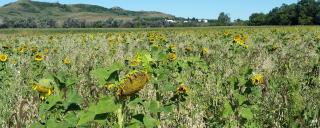
Wildlife Food Plots Seed Promotion Handout
Why food plots are Important
Placed correctly, food plots can provide an important resource for pheasants, offering a long-term food source and good quality cover during summer, fall and winter.
As opposed to supplemental feeding, food plots offer a more natural feeding scenario, reducing the risk of disease transfer.
Other species also benefit from food plots.
About this food plot mix
To benefit wildlife, including young pheasant chicks that depend on insects as a food source, this mix was developed using Neonicotinoid-free seed.
Neonicotinoids are systemic insecticides normally applied as a seed treatment and absorbed through the plant’s vascular system, making the entire plant toxic, including the pollen and nectar.
This mix contains an array of annual cool and warm season grasses and broadleaf species that, once established, will create a season-long food plot and provide cover for late-season nesting, broods and adult pheasants.
Flowering plants will attract insects critical to the diet of young pheasant chicks, while mature grasses and forbs will produce grains and seeds that provide food for pheasants of all ages.
Prep and planting
- Seedbed prep – Apply glyphosate following manufacturer’s directions prior to planting to reduce early weed competition.
- Seeding instructions – Sow seeds mid-May to early-June at a rate of 45 pounds (1 bag) per acre. Seed to a depth of three-quarters to 1 inch into a firm, weed-free seedbed to ensure proper seed to soil contact.
- Fertilizer (optional) – Applying fertilizer can increase the productivity of your food plot.
- Follow soil test recommendations.
- Prep and planting conditions will vary from site to site.
If you have questions about your unique situation, contact a PLI biologist for additional information.
Placement
Plant food plot adjacent to or within a quarter-mile of good winter habitat, such as established tree rows, cattail stands and/or dense grass cover.
Food plots should be placed on the leeward side of cover to prevent the plot from being covered by drifting snow.
Planting food plots near major roadways, livestock feed supplies and new tree plantings should be avoided.
Food plots should be placed on existing cropland only; native prairie or other grasslands should not be broken to plant food plots.
Weed control
This food plot mix is intended for use by pheasants and other wildlife.
Annual plants will likely establish after planting and will provide additional cover and food sources, which will benefit pheasants.
The Department does not recommend using herbicides to control annual, nonnoxious weeds.
However, controlling noxious weeds is required by state law and is the responsibility of the landowner.
Spot-spraying or spot-clipping of noxious weeds is encouraged to limit damage to the food plot.
Soil health
Planting food plots/cover crops may also provide soil health benefits.
Species selected for this mix may help reduce wind and/or water erosion, increase soil organic matter, capture and recycle nutrients in the soil profile, promote nitrogen fixation and reduce soil compaction.
Why is Game and Fish providing seed?
Since more than 93 percent of land in North Dakota is held in private ownership, it is critical that the Game and Fish Department work with private landowners to manage wildlife and wildlife habitat.
This food plot campaign is an addition to the many other Game and fish private land programs in which thousands of landowners participate.
Hunting access
Landowners in this food plot campaign are expected to allow reasonable hunting access on food plots and adjacent land.
This could include allowing access to a few hunters a year, putting up “Ask Before You Enter” signs (provided with seed), or enrolling land in the PLOTS program and opening it to walk-in public hunting.
Landowners may not charge a fee for hunting if accepting food plot seed through this campaign.
Additional resources
The Department can also provide additional financial and technical assistance to private landowners looking for help with habitat protection, enhancement and development by providing cost-share and rental payments through the PLOTS program.
Please contact the North Dakota Game and Fish Department for more information.
